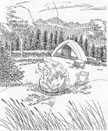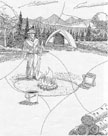required material for activities
(click to enlarge)

Puzzle 1

Puzzle 2
|
|
|
|
Learning Outcomes
Students will understand the nature of fire and know how to ignite,
maintain and extinguish a campfire.
|
Summary
Students will learn important fire safety practices through five activity
centres.
|
|
Activity Information
- Grade level: primary/junior
- Subject: visual arts, science and technology, dramatic arts
- Skills: problem solving, suggesting alternative answers
- Duration: 2-3 hours; can be completed in several shorter time periods
- Group size: any size
- Setting: indoors
|
|
Pre-Activity Preparation
Set up the 5 activity centres. Materials required:
- Activity Centre #1 - Safe and unsafe campfire pictures cut into
puzzles (see black line masters), paper and pencils.
- Activity Centre #2 - Paper and pencils, topic sheets cut and put
into hat, some props which can be used in the skits such as wood,
wool jacket, sleeping bag.
- Activity Centre #3 - Three covered trays, two large trays with signs
saying Objects That Burn and Objects That Do Not Burn, three blindfolds,
assorted items such as twigs, small rocks, tent pegs, pieces of cloth,
feathers and shells.
- Activity Centre #4 - large pieces of paper, pencils, crayons.
- Activity Centre #5 - large pieces of paper, word sheets, scissors,
glue, crayons.
|
|
Background Information
1. A safe campfire meets all of the following criteria:
- is built on bare rock or sand (mineral soil)
- is located far away from anything flammable, including overhanging
tree branches
- is a small campfire. e.g. you can sit within a metre of it comfortably,
the flames are not over one metre high and it can be controlled
- has a responsible person watching it at all times
- is made and put out with an adult supervising
- be sure open fires are permitted
2. An unsafe campfire meets one or more of the following criteria:
- is built on a hot, windy day
- is left without someone watching it,
- is too big. e.g., is more than a metre high, is too hot to be within
a metre, and cannot be controlled
- does not have a pile of wood for fuel, which means that the people
watching it must leave for more
- is built on organic soil and close to trees
3. Now to extinguish a fire
- Drown the fire with water. Stir ashes with a long stick to turn
over hot coals and ashes. Move rocks to find hidden embers and coals.
Drown again. Repeat procedure until the ashes stop smoking and hissing
and everything looks wet.
4. Weather
- Weather affects campfires in many ways and generally determines
the kind of fire that will be experienced.
- Wind -Wind increases the supply of oxygen to the fire. Wind may
blow sparks from your campfire to grass and trees around it. The sun
beats up grass and trees and the layer of dead leaves, needles and
grass and dries them out. This makes it easier for them to catch fire.
- Clouds -Clouds can cover the sun to make a day cooler. This means
that the trees and grass will not dry as fast as on a sunny day.
- Rain -Rain soaks into the grass, trees and layer of dead leaves,
needles and grass, which makes it hard for them to catch fire.
|
|
Activity
- Show a picture of a campsite with a campfire. Have students brainstorm
the kinds of things that they would find at a campsite with a campfire.
- Arrange these objects into two lists under the headings Objects
That Will Bum and Objects That Will Not Rum.
- From the information on these lists, draw a picture on the board
or on a felt board of a campsite with a campfire, placing the objects
where the class feels is best.
- From the information on these lists, draw a picture on the board
or on a felt board of a campsite with a campfire, placing the objects
where the class feels is best.
- Make another list of the weather conditions that would affect a
campfire. Do these conditions make a campfire safer or more dangerous?
- Discuss how students and their families put out their campfires.
Go through the correct procedure by either drawing it, simulating
it, or making a real controlled campfire in the yard. NOTE: Make sure
you have permission from the proper authorities if making a real controlled
campfire.
- Ask why the class thinks it is important to put out their campfires.
What might happen if you just left it going, or did not put it out
totally?
- Leave all the information on the board and divide the class into
five groups to rotate through the five centres.
Activity Centre #1 - Puzzles
Have the students sort and assemble the two puzzles included as black
line masters for this activity. When finished, students will decide
which picture is the safe campfire, and which is the unsafe campfire.
Activity Centre #2 - Skits
Have some groups write and perform a skit about where and how to build
a campfire. Have other groups develop a skit, play acting the proper
way to extinguish a campfire.
Activity Centre #3 - What Am 1?
Have enough prepared, covered trays to provide one tray for each pair
of children in the group, with the trays containing small objects that
are common to a campground. For example a small rock, twig, tent peg,
piece of cloth, feather, shell. Place a blindfold on one student per
pair. With the "sighted' partner helping, have the blindfolded student
feel the objects on a covered tray one at a time, and try to identify
each object.
When the first partner is finished, have the pair trade trays with
another pair within their group. The second partner is then blindfolded,
and tries to guess the objects in the tray. When the pairs are finished,
have them classiy the objects as Objects That Burn or Objects That Do
Not Burn. Have two empty trays available for this classification.
Activity Centre #4 - Cartoons
Have the students fold a large piece of paper in half three times so
that there are about eight squares showing. The students will draw a
picture in each square to tell a story. The story could be about an
unsafe fire or a fire that looked like it was out, but had some hidden
embers that turned into a forest fire.
Activity Centre #5 - Posters
Have the students create a poster teaching other students in the school
how to make and extinguish a safe campfire. What words should be on
the poster? What is the easiest way to get the message to the rest of
the school?
For younger grades, have the students draw a picture of a safe campfire
site. Provide a list of vocabulary words, and have the students cut
and paste, or copy these words out and place them on the appropriate
item in their picture. The words are: water, small campfire, bare rock,
sand, adult watching, ashes out wood pile.
When all groups have been through a cycle of the activities, have all
the small groups perform the skits they created in activity #2.
|
|
Evaluation
Observe and record students'understanding of a safe fire through their
ability to recognize flammable materials and depict the elements of
fire safety in the skits, cartoons and posters.
|
|
Resources
- Focus on Forests, Primary/Junior, Ontario Ministry of Natural Resources
- Saving the Forests: A Rabbits Story, by Janet Richecky, ISBN 0-516-08119-5
|
|


 Home > Advanced > Teacher's Aids > Classroom Activities > A Safe Fire
Home > Advanced > Teacher's Aids > Classroom Activities > A Safe Fire






 Home > Advanced > Teacher's Aids > Classroom Activities > A Safe Fire
Home > Advanced > Teacher's Aids > Classroom Activities > A Safe Fire

